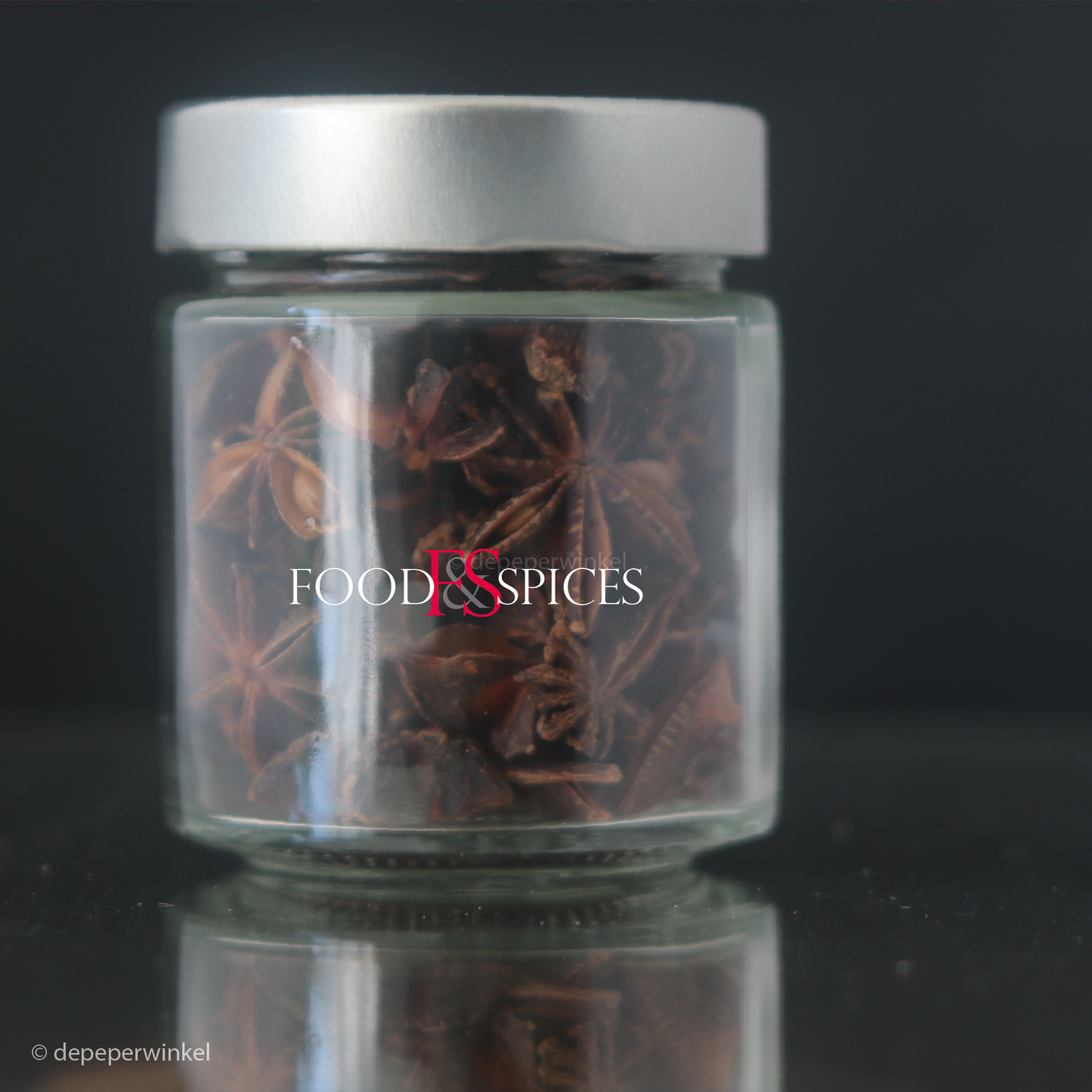depeperwinkel
Star anise
Star anise
In stock
Unable to load availability for pickup
Star anise is, as the name suggests, a star-shaped spice consisting of the fruit box and the seeds. The fresh, light green fruit has a diameter of approximately 3.5 cm and has approximately eight compartments or follicles. Each consists of a carpel with one seam, so that it only opens on one side, and contains one shiny, brown seed.
The fruit is picked when it is dark brown, before it is fully ripe, to prevent the seeds from falling off. After drying, the carpel appears lignified, rock hard.
The fruits come from the real anise tree or Illicium verum, a ten to twenty meter high tree with shiny, leathery leaves. It flowers twice a year. Our star anise comes from the mountainous and relatively cool Lang Son in Vietnam, the natural habitat of the tree.
This one gives fruit from March to April and from August to September. There are two harvests per year, each lasting three to four months, because the fruits have to be picked by hand once they are sufficiently ripe.
Star anise is harvested from the fifth year. During its productive life, the tree gives an increasingly higher yield and the quality of the star anise also increases. Trees that are twenty to thirty years old give the best star anise.
Our star anise is grown and exploited naturally, without the use of chemical fertilizers and/or pesticides.
A piece of history
Star anise came from China via India to the Arab world, where it acquired a place in Persian cuisine. It was not introduced to Europe until the sixteenth century. Europe was introduced to star anise thanks to Thomas Cavendish, who brought the fruit from the Philippines to England in 1578. It would take some time before the first star anise could be bought there. In 1601, the first dried star anise was for sale in London.
Soon after, star anise was brought from China via the tea routes through Russia. This is why star anise got its nickname Siberian cardamom.
Today, China and Vietnam are the main producing countries, but star anise is also grown in Laos, Korea, Japan and the Philippines.
The Chinese name ba jiao 八角 means octagonal herb, which is exactly what it is, but in European languages the shape, taste and country of origin are often combined. The name 'badian', which is also used, is derived from the Persian badiyan, which is said to be derived from the Chinese name ba jiao.
The botanical name Illicium is derived from Latin. Ilicere means allure and refers to the rich taste.
Smell and taste
Both the carpels and the seeds are aromatic, the carpel being more aromatic than the seeds. There is no reason to remove the seeds unless you have the specific goal of intensifying the flavor of a single fruit.
Due to the high content trans-anethole star anise has a strong, sweet anise flavour. Pure anethole is more than ten times as sweet as sugar. Star anise contains no sugars. Our Lang son star anise contains more than 70% essential oil, of which no less than 95-98% trans-anethole. You experience this immediately when the fruit absorbs moisture and releases its full aromas.
In addition to trans-anethole, the essential oil in star anise contains estragole (anise aroma) and limonene (orange aroma), both about 2%, and traces of α-pinene, p-cymene, eugenol, linalool, camphene and β-myrcene.
Common (Spanish) anise (Pimpinella anisum) contains just like star anise trans-anethole, and therefore has a similar flavor, but usually milder. Anise is not related to star anise. The same applies to fennel (Foeniculum vulgare), which also trans-contains anethole.
Usage
Star anise is inextricably linked to Chinese, Taiwanese and Vietnamese cuisine. Elsewhere in Southeast Asia star anise plays a modest role, in Indonesian cuisine it is hardly used, in Thai cuisine not at all.
The star anise fruit is ground or used whole, as in red cooking, a Chinese cooking technique. When the whole fruits are used, they are removed after cooking, as in the preparation of mulled wine and stewed pears.
The flavor palette of star anise is very similar to that of licorice and common anise, and combines well with tomato and basil.
Star anise is used in Italian liqueurs such as Galliano and Sambuca, in Absinthe and in French Pastis, and in the following spice mixtures:
- thirteen spice (5-spice) (China)
- five spice (China)
- garam masala (India)
Features:
- 100% dried fruits of the Illicium verum
- origin: Lang Son, Vietnam
- batch: 220220
Assortment
- available in glass and stand-up pouch (no test tubes)
- larger quantities on request
Gift wrapping
- The jar is available in a tasteful gift packaging, consisting of a cube box filled with black tissue paper
- For an overview of our gift packaging, please refer to the gift packaging section
General advice
- Feel free to grind star anise in advance, but keep in mind that it will quickly lose its aromas, the shelf life of ground star anise is only a few months
Save:
- store your star anise in a closed container
- preferably store in a dark, dry and cool place
- at least good until September 2026 (09/26)
- This expiration date is an indication
Batch number
The batch number helps us trace which supply an item originates from. It is stated on the packing slip and the invoice









